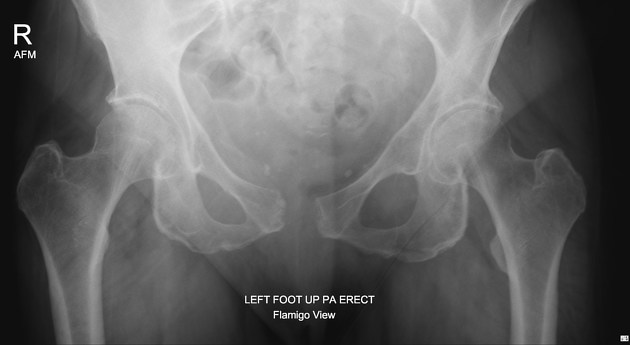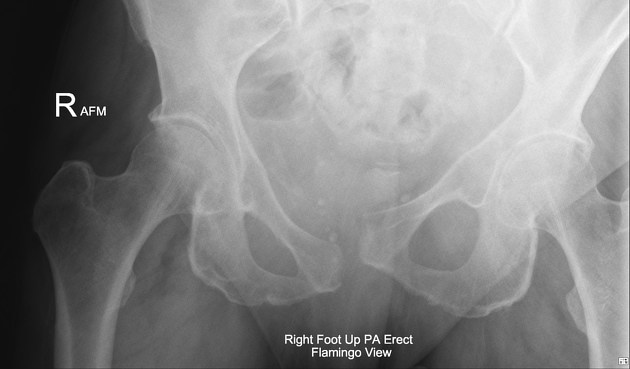The flamingo view series of the pelvis is a specialized orthopedic series consisting of three separate pelvis projections consisting of a neutral, left foot raised and right foot raised view. Normal total translational motion at the pubic symphysis between alternate leg views is 2-5 mm, with greater motion seen in multiparous women (3.1 +/- 1.5 mm) versus men and nulliparous women (approximately 1.5 +/- 1.0 mm).2
On this page:
Indications
It is used for assessing instability of the pubic symphysis, often in the context of previous pelvic trauma. This projection should only be performed under specialist supervision or referral.
Patient position
The series is comprised of three separate projections traditionally performed AP erect, however patients with balance issues can benefit from a PA projection.
-
neutral
patient is erect with both feet evenly planted on the ground
standing AP (or PA) with the posterior aspect of the pelvis resting against the upright detector
patient's hands are out of the way of the imaging field
-
left foot raised
patient is erect with left foot off the floor for the projection, patient is reminded to place weight on right foot
standing AP (or PA) with the posterior aspect of the pelvis resting against the upright detector
patient's hands are out of the way of the imaging field
-
right foot raised
patient is erect with right foot off the floor for the projection, patient is reminded to place weight on left foot
standing AP (or PA) with the posterior aspect of the pelvis resting against the upright detector
patient's hands are out of the way of the imaging field
Technical factors
AP/PA erect dynamic projection
-
centering point
the midpoint of the anterior superior iliac spine and the pubic symphysis
-
collimation
laterally to the skin margins
superior to include the anterior superior iliac spine
inferior to the proximal third of the femur
-
orientation
landscape
-
detector size
35 cm x 43 cm
-
exposure
70-80 kVp
20-30 mAs
-
SID
100-150 cm
-
grid
yes
Image technical evaluation
clear annotations indicating what image the projection is in the series
entirety of the superior and inferior pubic rami visulised
proximal femur visible
Practical points
The flamingo view is often ordered under specialized orthopedic guidance, given the circumstances around requesting such a series the patient is often in significant pain. One must take into account patient mobility, and if possible, not perform the projection alone. Patients who are only able to stand for short periods of time need clear demonstration of how the radiographic examination is to take place, to avoid additional time out of the bed. Although routinely performed AP, performing the projection PA has the benefit in giving the patient an upright detector to use for stabilization if balance is lost.







 Unable to process the form. Check for errors and try again.
Unable to process the form. Check for errors and try again.